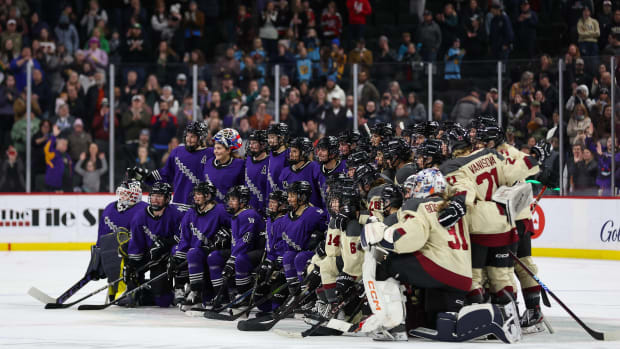Deep below the surface of the Salish Sea lurks a nine-brained, eight-legged, blue-blooded creature that can change into any color its three hearts desire. Its soft body can weigh more than 100 pounds and stretch up to 20 feet across before squeezing into the smallest crevices. When it’s not perfectly disguised among the rocks and caves, it awkwardly scuttles across the ocean floor or cuts through the water like an ink-filled jet stream. It has been a source of awe and legend for centuries.
When the poorly constructed Tacoma Narrows Bridge—appropriately nicknamed Galloping Gertie for its worrying wobble—collapsed in 1940, legend had it that a 600-pound octopod living below wrapped its tentacles around the structure and pulled it under the water. While the existence of this colossus has yet to be confirmed, at least by anyone who has lived to tell the tale, the ruins of that bridge provide the perfect den for one of the most incredible members of the aquatic world: the giant Pacific octopus.
As the largest known octopus species, the giant Pacific octopus is native to the cold coastal waters of the North Pacific. Around the Puget Sound, which was cut off by glaciers and provides an ideal environment for bountiful marine life, the giant Pacific octopus has become a symbol of the Pacific Northwest. Seattle’s new NHL team, which begins play tonight, even chose the more mythic version, the Kraken, as its mascot.
Super-sized cephalopods have long captivated mythmakers—and more recently, scientists, hockey enthusiasts and filmmakers—but for a brief period in the 1960s they also inspired a short-lived sport: octopus wrestling.
Gary Keffler and the Mudsharks were local legends in Tacoma, Wash. No, they were not one of the many grunge bands trying to rock their way into the Seattle scene in the 1990s. This was a dive team and several members, including Keffler, represented the United States in worldwide competitions for free-diving and spear-fishing in the ’50s and ’60s. Because of this, they were the perfect ambassadors for encouraging people to pick up the sport.
Keffler says this was a time when a more general interest about what lived in the ocean was budding. Science-fiction novels and movies were growing in popularity and inspiring people to see for themselves what aliens might exist here on Earth.
As diving rose in popularity around the country, the Mudsharks held different competitions at Tacoma’s local beaches. They did various fishing and breath-holding contests, but they wanted to develop a team event. And since the world’s biggest octopus species resides in the Pacific Northwest, “we just kind of came up with it,” Keffler says.
And thus a new event was born: the World Octopus Wrestling Championship.
The concept was simple: Divers would come in three-man teams to Titlow Beach, right near where the ruins of Galloping Gertie remain. The free-divers would go in the first heat, and those who used scuba gear would go in the second. The divers would march out into the water and scour the Puget Sound for any sign of an octopus. Once a team wrangled one from its den, the divers would bring it up to the surface to be weighed—it was a point per pound for those who used gear, but three points per pound for the iron-lunged free-divers.
The competition was held in the early 1960s and even televised locally in ’63, when they had more than 100 divers participate in front of a crowd of thousands, Keffler says. Nervous that there may not be enough octopuses, Keffler and his buddies went out the week before and caught nine or 10 to add to the area. (Nearly 30 octopuses were rassled in that year’s event, proving it a needless worry.)
At the start of the competition, divers lined up on the shore similar to a triathlon. “They would say, Go! and everybody heads into the water with all the scuba gear on. But you’re not quite like a triathlete, you're kind of waddling in the water, like a duck,” says Ron Frederick, who participated as a high schooler with his father, Karl.
Although today people travel from around the world to this region to see the giant Pacific octopus in its squishy flesh, the World part of the competition title was a bit of a misnomer. Most, if not all, of the participants were from the Pacific Northwest. And the Wrestling? Well that was a smidge exaggerated, too.
The title suggests that the most difficult task was squaring off with a creature that had six more arms, eight more brains and a couple of additional hearts than the average human, but it was locating the octopuses that often proved to be most challenging.
Octopuses are solitary animals that dress themselves in camouflage to hide from both predators and prey, so one of the best ways to find one is by looking for its compost bin. The diet of a giant Pacific octopus is similar to something you might find under the Pesce section of an Italian menu: shrimp, crab, clams, scallops, lobster. Shells and other remnants from mealtime would be scattered close to where an octopus might set up camp, so that’s where the search would begin, Keffler says.
The Mudsharks were part of the free-diving heat. With a den identified, Keffler and his teammates would take turns wiggling the octopus free before needing to come up for air and tagging the next person into the underwater ring. Once it was sufficiently loosened, it was time to tuck it into a half nelson and go.
An octopus may put up a fight by wrapping its tentacles around a diver or pulling off a mask, but it eventually succumbs to its opponent, Keffler says. “They're very, very mild and they just didn't like people, really. They didn't want to be around you.”
Keffler says his MudSharks took the title all three (or four—it was a long time ago) years the competition was held. A few of the octopuses would be kept around in tanks on the beach throughout the day for spectators to gawk at. A couple went off to local aquariums, but the majority were released back into the water.
“A lot of people have adventure in them and they wanted to see what was under water. A lot of them found an octopus and got wrestling so that was another adventure for them to do under there,” Keffler says. “But it faded into people kind of appreciating all the different underwater creatures and wanting to learn about it rather than just fishing for sport.”
Not every diver who participated in octopus wrestling was world-renowned. Take the Fredericks, who were from Steilacoom, Wash. When Karl got word of the competitions happening nearby, he and his teenage son, Ron, decided to check it out. Water sports were more of a hobby rather than a lifestyle for the Fredericks, so they opted to do the less taxing heat with their scuba gear, which allowed them to venture out a bit deeper in hopes of finding a bigger octopus. (Ron says their team once came in third with a 56-pounder.)
Ron and Karl would take along a burlap sack, turning their wrestling match into more of an underwater bank heist. Once they found an octopus, they would put its body into the sack and stuff the legs in, all to hopefully avoid being left in a cloud of ink. “I was a high school wrestler myself,” Ron says. “It was not any kind of competition between me and the octopus.”
He would go on to prove that again, and not just in a competition setting.
On a spring day in 1964, Ron and Karl were diving at Salter’s Point in Steilacoom. The pair didn’t anticipate bringing back anything big during the dive, but when Karl came across a giant Pacific octopus, he couldn’t help himself.
As Karl neared the octopus to grab it, the octopus decided to grab back. Ron, who was a few yards away, turned around to see his dad’s legs completely wrapped up by this “some 50-pound octopus,” unable to wiggle free or swim away.
Ron seized his dad by the life vest and kicked up to the surface, with the octopus coming along for the ride. After he brought his mollusk-encased father to shore, it was time to start untangling. “Those suction cups are pretty powerful,” Ron says. “So we had to gradually unravel that thing off of my dad.”
Perhaps a preview of his future, Ron went off to college later that year on a Navy ROTC scholarship and served 10 years as a Navy SEAL officer—which included a deployment in Vietnam—before his career in public service. He is now mayor of Dupont, Wash., a small coastal town of about 10,000.
Keffler built his life around the water, too. In 1963, he nabbed silver in the individual event at a world spear-fishing championship in Brazil, with Team USA taking bronze. For “a number of years” he was in the top 10 in the world for breath-holding, and his deepest dive was around 135 feet. In one competition, he dove 60 feet to save another competitor who didn’t come back up. Another time he jumped out of a helicopter to help a rescue effort during a hydroplane accident.
As the sport grew in popularity, so did his business, Underwater Sports, which sells gear and gives scuba diving lessons. “We had classes signed up almost six to eight months in advance for two years back then,” Keffler says. “Everybody wanted to get into it.” His success as a diver even led to a few appearances on screen, like when he played the body double of Lloyd Bridges’s character Mike Nelson, a diving expert in the T.V. show Sea Hunt.
After dedicating his life to diving, it would turn out that diving would eventually give back to Keffler when he needed a heart transplant at 59 years old. Once doctors found a perfect match, Keffler received a 21-year-old heart, and his lungs ensured the transplant was successful. “After all those years of diving, my lungs were very, very healthy,” he says. “I had huge lungs.”
Keffler hasn’t been able to dive since but is still a competitor at heart—now one shy of his former wrestling opponent. He fishes, plays in poker tournaments and is aiming to be one of the longest-surviving heart transplant patients. He celebrated his 87th birthday on Sept. 8 and the 28th anniversary with his new heart on Aug. 7, his second birthday; he requests gifts on both days.
Frederick with a career in the armed forces and politics, Keffler a career as a professional free-diver, businessman and longtime heart-transplant recipient; yet, more than 50 years later, both men say they frequently field calls about those few short years in octopus wrestling.
“The adventure of wrestling an octopus, well it’s an interesting thing because it’s an interesting animal, which a lot of people don't understand how meek and mild they are, but all their qualifications are the thing that draw people in,” Keffler says. “The octopus is a phantom animal.”
Grace’s biggest secret is in danger of becoming revealed when her daughter, Lee, comes across an old trophy of her mother’s. Shortly after finding the trophy, Lee falls in love and is unknowingly sending a beacon to the underworld and leaving Grace to battle the undertow.
If anything could be said about me/It’d be that I’m a winner who loves competition/I’ve been this way since I was 3. Grace is singing while emphatically fighting off different sea creatures like a Marvel superhero. From beating her sisters in a tree-climbing contest to tackling the high school quarterback when she wasn’t allowed to join the team, Grace has never backed down in any battle. I never lose, she repeats as she kicks away the three eels sparking with electricity.
“That's the most physical thing I've ever had happen in any of my shows,” says Justin Huertas, the playwright of The Last World Octopus Wrestling Champion. The musical, which was put on in 2019 by ArtsWest Playhouse and Gallery in Seattle, centers around the title character, Grace, who is “a badass Filipino mom.” After winning the World Octopus Wrestling Championship when she was 25, Grace kept the octopus instead of returning it to the sea, breaking a pact between humans and the underworld. That octopus splits in half and turns into two children: Lee and her new love interest, Nia. Lee starts showing more and more octopus-like tendencies, and Grace’s fights against the undertow become even more taxing.
The singing and choreography involved in Grace’s songs were likely more physically demanding than what was required in the real underwater competitions. But Huertas was inspired more by mythology than actual wrestling. All of his musicals are rooted in fantasy, centered around marginalized heroes and queer love, and set in Seattle, which means he likes to pull from common tales of the region. When he was commissioned to write this musical, he was inspired by the legend of how Galloping Gertie collapsed.
“As a kid, every time we drove across Narrows Bridge,” Huertas says, “I would look at the water and be like, You're out there somewhere.”
Like the story of the 600-pound octopus that was apparently tired of looking at the shoddy craftsmanship of that bridge, octopus wrestling, too, has been lost to the passage of time—and laws. The championship fizzled out in the mid 1960s, and in ’76 the harassment or capture of an octopus without the intent of eating it was officially made illegal by the state of Washington; hunting giant Pacific octopuses is even prohibited in many areas around the Puget Sound today.
But the Pacific Northwest’s iconic creature is making its athletic return. Hockey hasn’t been in the area since the Seattle Totems of the Western Hockey League dissolved in 1975, but now there will be Kraken scrapping. Just don’t expect to see any octopuses wrestling.
More From SI:
• The 2021 Octopus Awards
• 75 Years of NBA Coulda-Beens
• Iman Shumpert Talks Dancing With the Stars
• Inside Kris Bryant's Journey








